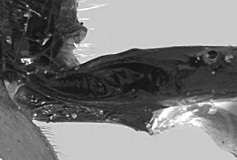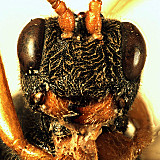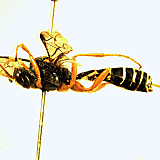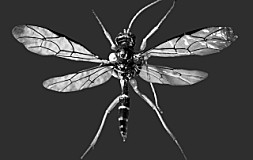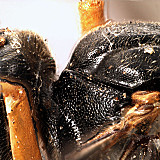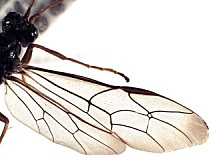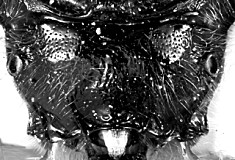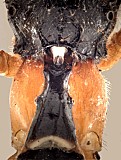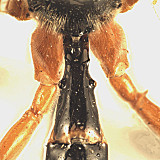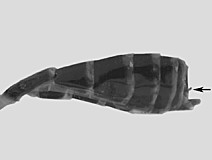Type species: Gauldia levis Zhaurova, 2009.
Gauldia Zhaurova, 2009
Species description: Female. Face deeply and densely punctate, slightly rugose medially and basolaterally. Prominent interantennal ridge extends posteriorly, splitting into 1 median and 2 lateral carinae beyond posterior margin of torulus. Ocelli fairly small and not distinctly raised, distance between eye margin and lateral ocellus 1.2 times distance between lateral ocelli. Frons polished medially amid carinae; vertex finely punctate throughout; distinct patch of matt sculpture extending diagonally from lateral ocellus to eye, with a distinct, weakly curved sulcus extending from lateral ocellus to eye. Pronotum uniformly punctate laterally. Mesopleuron quite densely punctate, lightly setose, with a fairly small impunctate area posteromedially. Metapleuron uniformly densely but finely punctate, setose. Propodeum with transverse carinae absent or indistinct.
Gauldia shares two distinctive features of the petiole with Hypopheltes, namely the glymma with the deep part of the pit posterior to the dorsal tendonal attachment (dta) and the posteriorly excavated pit mid-dorsally behind the dta. The mid-dorsal pit and its posterior concavity limit the depth of the glymma on either side of the petiole, and the two structures are thus unlikely to be independent. Nevertheless, this is a complex character unique to these genera, strongly suggesting a close relationship. Gauldia is treated here as a separate genus (relative to Hypopheltes) largely on the basis of sculptural differences on the head and propodeum, the latter largely responsible for its intermediate placement between Hypopheltes and Westwoodia in our analyses (Zhaurova and Wharton 2009): 69-76. The genus is known from a single species; males are thus far unknown; Gauld (1984) treated this as an undescribed species under Hypopheltes.
Holotype of G. levis: ♀, with four labels in addition to holotype label.
First label with three lines; first line: Bred from larvae second line: 1-vii-1959 third line: No. 525. Second label with four lines; first line: Australia second line: Victoria third line: Nerrina fourth line: M.F. Leask. Third label with four lines; first line: Adults = second line: Pseudoperga third line: belinda Kirby fourth line: ♀♂ recog Leask. Fourth label with two lines; first line: Brit. Mus. second line: 1959-440 (BMNH).
There are no specimens currently determined for this OTU, or those specimens determined for this OTU are not yet mappable.
This study would not have been possible without the groundwork provided by Ian Gauld’s study of the Australian fauna, and we are particularly grateful for his assistance in many aspects of this study. We also thank the following curators and researchers for extended loans of the material used for the revision of Scolobatini and Westwoodiini: David Wahl (AEIC), John LaSalle (ANIC), Ian Gauld and Gavin Broad (BMNH), Andy Bennett (CNC), Gabriel Melo (DZUP), Anders Albrecht and Pekka Malinen (FMNH), Ronald Zúñiga (INBio), Ken Walker (MVMA), Hege Vårdal (NHRS), Chris Burwell (QM), and Dave Furth (USNM). Matt Yoder provided considerable assistance along the way, particularly with databasing. Images used here were obtained through the combined efforts of Kira Zhaurova, Heather Cummins, and Patricia Mullins. Our use of PURLs (http://purl.oclc.org) follows the example of their use in publications by Norm Johnson. This material is based upon work conducted at Texas A&M University and supported by the National Science Foundation’s PEET program under Grant No. DEB 0328922 and associated REU supplement nos DEB 0723663 and DEB 0616851. Page last updated April, 2011.
This material is based upon work supported by the National Science Foundation under Grant Number DEB 0328922 with REU supplements DEB 0723663 and 0616851.
Any opinions, findings, and conclusions or recommendations expressed in this material are those of the author(s) and do not necessarily reflect the views of the National Science Foundation.


